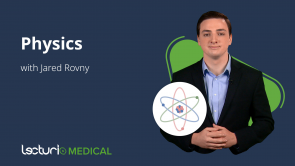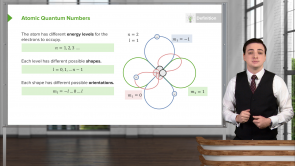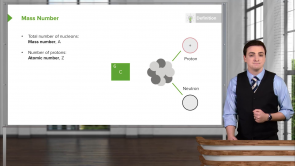Effective Nuclear Charge

Über den Vortrag
Der Vortrag „Effective Nuclear Charge“ von Jared Rovny, PhD ist Bestandteil des Kurses „Electronic Structure“.
Quiz zum Vortrag
Why do the electrons in the outer orbitals of an atom experience a lower “effective" nuclear charge?
- The electrons present in the inner orbitals repel the electrons occupying the outer orbitals.
- The neutrons in the nuclei have an effect such that they lower the overall "effective" nuclear charge experienced by the outer orbital electrons.
- There is interference between the two different electron spins in the outer orbitals which results in a lower "effective" interaction with the charge of the nucleus.
- The electrons in the outer orbitals are not paired and unstable hence they experience a lower effective charge from the nucleus.
- The motion of an electron in the outer orbitals causes a slight change in its real charge due to relativity.
What is the “uncertainty principle”?
- There is an inherent uncertainty in observing quantities such as the position and momentum of a particle such that knowing the position of a particle will result in uncertainty in the measurement of momentum and vice versa.
- There is an experimental uncertainty in observing physical quantities, due to the constant inaccuracies that our measurement tools have.
- There is an uncertainty in regard to the nature of the objects we observe at the microscopic scale.
- There is an uncertainty in whether a particle had existed before it was measured or the act of measurement created the particle.
- The quantum mechanical uncertainty associated with the many types of fundamental particles and their probabilities.
If a particle's position is described as a probability wave, how is the particles momentum related to this wave?
- The particles momentum is related to the wavelength of the wave.
- The particles momentum has a relation with the amplitude of the wave.
- The particles momentum is related to the frequency of the wave.
- The particles momentum is related to the intensity of the wave.
- Momentum is a classical quantity and does not relate to the probability wave of a particle.
The particle’s location is best described by a probability wave showing the probability of the particle being in that location. How does this picture help in answering the question of why we cannot be certain about the location and momentum of the particle simultaneously?
- When the probability wave of the position of the particle has a definite wavelength (or momentum), we can no longer be certain about the location of the particle as the probability wave with a definite wavelength will be spread out in space. And if the probability wave of the particle is peaked at a certain location and zero at other locations which means that the particle has a definite location, then this wave must be a superposition of many waves with different wavelengths, hence the momentum of the particle is uncertain.
- When the probability wave of the particle is peaked at a certain location which means that the particle has a definite location then we cannot be certain about the momentum of the particle as we do not know the particles speed. And if we know the particle speed then we cannot know its location as it is spread out in space.
- When the probability wave of the particle has a definite frequency or momentum we cannot be certain about the location as the wave is spread out in space.
- When the probability wave of the particle has a definite amplitude or momentum we cannot be certain about the location of the particle as it has different amplitudes at different locations.
- When the probability wave of the position of the particle has a definite wavelength we can be certain that the particle is located within that wavelength. And when the particle is a superposition of waves with different wavelengths we cannot be certain about the particles location as there are different wavelengths in different locations. The same is true about the momentum but in regard to the frequency of the wave.
What is the uncertainty principle relation for momentum and position? And what are the values of the Planck constant h and ħ?
- Δx.Δp ≥ ħ, ħ = h/(2π) and h = 6.626 X 10⁻³⁴ J.s
- Δx.Δp ≥ ħ, ħ = h/(π) and h = 6.626 X 10⁻³⁴ J.s
- Δx/Δp ≥ ħ, ħ = h/(2π) and h = 6.626 X 10⁻³⁴ J.s
- Δx.Δp.ħ ≥ 1, ħ = h/(π) and h = 1.055 X 10⁻³⁴ J.s
- Δx².Δp² ≥ ħ, ħ = 2πh and h = 1.055 X 10⁻³⁴ J.s
Diese Kurse könnten Sie interessieren
Kundenrezensionen
5,0 von 5 Sternen
| 5 Sterne |
|
5 |
| 4 Sterne |
|
0 |
| 3 Sterne |
|
0 |
| 2 Sterne |
|
0 |
| 1 Stern |
|
0 |







